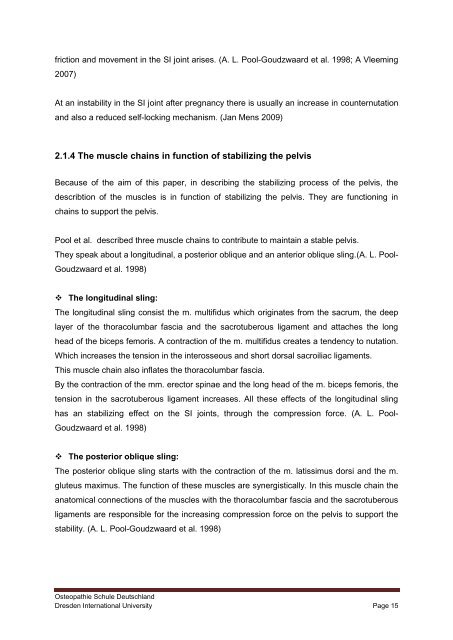Pelvic girdle pain and relevance of ASLR testing: A ... - Cindy Verheul
Pelvic girdle pain and relevance of ASLR testing: A ... - Cindy Verheul
Pelvic girdle pain and relevance of ASLR testing: A ... - Cindy Verheul
You also want an ePaper? Increase the reach of your titles
YUMPU automatically turns print PDFs into web optimized ePapers that Google loves.
friction <strong>and</strong> movement in the SI joint arises. (A. L. Pool-Goudzwaard et al. 1998; A Vleeming<br />
2007)<br />
At an instability in the SI joint after pregnancy there is usually an increase in counternutation<br />
<strong>and</strong> also a reduced self-locking mechanism. (Jan Mens 2009)<br />
2.1.4 The muscle chains in function <strong>of</strong> stabilizing the pelvis<br />
Because <strong>of</strong> the aim <strong>of</strong> this paper, in describing the stabilizing process <strong>of</strong> the pelvis, the<br />
describtion <strong>of</strong> the muscles is in function <strong>of</strong> stabilizing the pelvis. They are functioning in<br />
chains to support the pelvis.<br />
Pool et al. described three muscle chains to contribute to maintain a stable pelvis.<br />
They speak about a longitudinal, a posterior oblique <strong>and</strong> an anterior oblique sling.(A. L. Pool-<br />
Goudzwaard et al. 1998)<br />
The longitudinal sling:<br />
The longitudinal sling consist the m. multifidus which originates from the sacrum, the deep<br />
layer <strong>of</strong> the thoracolumbar fascia <strong>and</strong> the sacrotuberous ligament <strong>and</strong> attaches the long<br />
head <strong>of</strong> the biceps femoris. A contraction <strong>of</strong> the m. multifidus creates a tendency to nutation.<br />
Which increases the tension in the interosseous <strong>and</strong> short dorsal sacroiliac ligaments.<br />
This muscle chain also inflates the thoracolumbar fascia.<br />
By the contraction <strong>of</strong> the mm. erector spinae <strong>and</strong> the long head <strong>of</strong> the m. biceps femoris, the<br />
tension in the sacrotuberous ligament increases. All these effects <strong>of</strong> the longitudinal sling<br />
has an stabilizing effect on the SI joints, through the compression force. (A. L. Pool-<br />
Goudzwaard et al. 1998)<br />
The posterior oblique sling:<br />
The posterior oblique sling starts with the contraction <strong>of</strong> the m. latissimus dorsi <strong>and</strong> the m.<br />
gluteus maximus. The function <strong>of</strong> these muscles are synergistically. In this muscle chain the<br />
anatomical connections <strong>of</strong> the muscles with the thoracolumbar fascia <strong>and</strong> the sacrotuberous<br />
ligaments are responsible for the increasing compression force on the pelvis to support the<br />
stability. (A. L. Pool-Goudzwaard et al. 1998)<br />
Osteopathie Schule Deutschl<strong>and</strong><br />
Dresden International University Page 15


